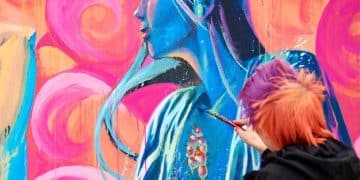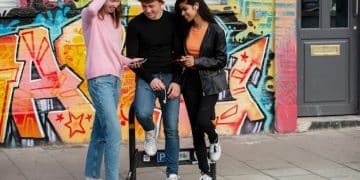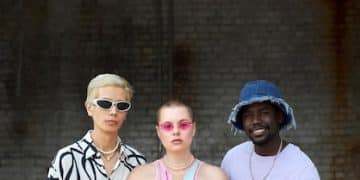Streetwear Photography: Capturing Urban Style Essence
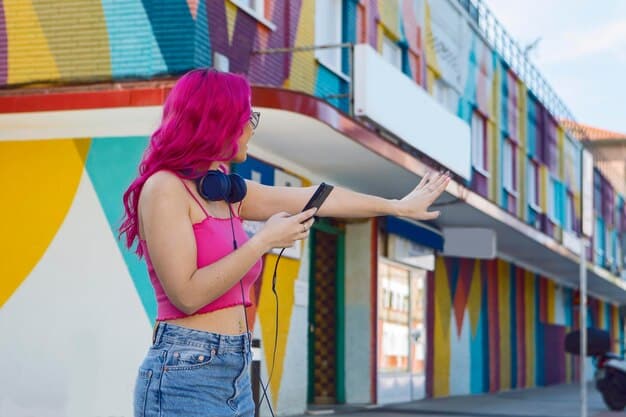
Streetwear Photography: Capturing the Essence of Urban Style delves into the dynamic art of documenting urban fashion, exploring techniques, aesthetics, and cultural nuances to authentically represent the evolving landscape of city street culture through impactful imagery.
The vibrancy of urban culture finds its most authentic expression through the lens of streetwear photography: capturing the essence of urban style. This unique art form goes beyond mere fashion documentation; it is a visual narrative, mirroring the pulse of city life and the individual stories woven into its fabric. It’s about understanding the subtle interplay between clothing, environment, and personal swagger, turning fleeting moments into timeless statements of identity and trend.
The Foundations of Streetwear Photography
Streetwear photography is more than just taking pictures of clothes; it’s about capturing a cultural phenomenon. It requires a keen eye for detail, an understanding of urban aesthetics, and the ability to connect with subjects in their natural environment. This genre thrives on authenticity, reflecting the genuine style and attitudes of people on the street rather than staged studio shots.
To truly excel, a photographer must immerse themselves in the streetwear scene, appreciating its origins in subcultures like hip-hop, skate, and surf. This understanding allows them to anticipate trends and identify iconic pieces, transforming simple outfits into powerful visual narratives. The goal is to articulate the silent language of fashion as spoken on the city’s concrete runways.
Understanding the Streetwear Aesthetic
The aesthetic of streetwear photography is rooted in authenticity and raw urban grit. It embraces imperfections, natural light, and the spontaneity of candid moments. The focus often lies on bold graphics, oversized silhouettes, and eclectic combinations that speak to individuality and counter-culture influences. It’s less about polished perfection and more about capturing the unfiltered spirit of the streets.
- Authenticity: Prioritize real moments and genuine expressions over posed shots.
- Dynamic Composition: Utilize urban landscapes to create visually engaging backdrops.
- Vibrant Colors: Leverage the rich palette of graffiti, neon signs, and diverse clothing.
- Storytelling: Each image should convey a fragment of a larger urban narrative.
The aesthetic is also highly influenced by the latest trends, which means photographers must constantly stay updated. This involves following prominent streetwear brands, influential designers, and major cultural events that shape the movement. Being informed allows the photographer to not just capture what is, but also foresee what is emerging, positioning their work at the forefront of the style curve.
Furthermore, the lighting in streetwear photography often utilizes the harsh, yet dramatic, city lights. This refers to the dappled sunlight filtering through buildings, the neon glow of storefronts at night, or even the shadows cast by towering structures. These elements contribute to the raw, unpolished feel that is quintessential to the genre, adding depth and mood to each photograph.
It is crucial to develop a signature style that differentiates one’s work. While embracing existing aesthetics, the most impactful streetwear photographers infuse their unique vision, whether through specific editing techniques, consistent composition choices, or a distinct way of interacting with their subjects. This personal touch is what elevates a good photo into an iconic one, making it recognizable and memorable within the vast digital landscape.
Essential Gear for Urban Photography
While the essence of streetwear photography lies in artistry rather than equipment, having the right tools can certainly enhance your capabilities. A versatile camera body, reliable lenses, and a few key accessories can make a significant difference in capturing high-quality images in dynamic urban settings. However, it’s important to remember that the best camera is often the one you have with you.
Many photographers start with a basic DSLR or mirrorless camera, which offer excellent control over settings and image quality. These cameras provide flexibility, allowing photographers to adapt to various lighting conditions and fast-paced scenarios inherent in street photography. The choice between DSLR and mirrorless often comes down to personal preference for weight, size, and electronic viewfinder capabilities.
Camera Bodies and Lenses
For camera bodies, models that offer good low-light performance and fast autofocus are highly recommended due to the often unpredictable lighting of urban environments. Full-frame sensors typically perform better in low light, producing cleaner images with less noise, though APS-C sensors are more compact and often more affordable. The balance between portability and performance is key for street photographers who are constantly on the move.
- Mirrorless Cameras: Lightweight, compact, and often feature advanced autofocus. Examples include Sony Alpha series, Fujifilm X-series.
- DSLR Cameras: Robust, excellent battery life, and a wide range of lens options. Examples include Canon EOS series, Nikon D-series.
- Prime Lenses: Offer superior image quality, wider apertures for low light and shallow depth of field, ideal for capturing sharp subjects with blurred backgrounds. Common focal lengths are 35mm and 50mm.
- Zoom Lenses: Provide versatility for different scenes without changing lenses, but might compromise on aperture. A 24-70mm or 70-200mm covers many situations.
When selecting lenses, focus on those that are durable and have quick, quiet autofocus. Prime lenses, such as a 50mm f/1.8 or a 35mm f/1.4, are popular for their sharpness, ability to perform well in dim light, and the pleasing background blur (bokeh) they can produce. These characteristics are particularly effective for isolating subjects in a busy urban backdrop, emphasizing the streetwear outfit.
Zoom lenses, on the other hand, provide incredible flexibility, allowing photographers to quickly recompose shots without physically moving. A 24-70mm f/2.8 is a staple for its versatility, covering wide-angle cityscape shots to tighter portraits. For capturing details from a distance or compressing backgrounds, a 70-200mm f/2.8 zoom lens can be invaluable, especially when trying to remain inconspicuous.
Accessories for Enhanced Shooting
Beyond the camera and lenses, a few accessories can significantly improve the street photography experience. A comfortable camera strap is essential for long shooting days, preventing fatigue and ensuring the camera is always ready. Spare batteries are a must, as urban exploring can deplete power quickly, especially when reviewing images or using live view.
A durable camera bag that allows for quick access to gear is also crucial. It protects equipment from the elements and potential bumps while navigating crowded streets. Additionally, a strong, portable tripod can be useful for low-light shots or creating time-lapses, though it may not be necessary for every street photographer who prefers a lightweight setup.
Finally, a reliable set of memory cards with fast write speeds is vital to ensure that no precious moment is missed due to buffer delays. Consider carrying multiple smaller cards rather than one large one, as this minimizes the risk of losing all your shots if a card becomes corrupted. These seemingly minor details contribute significantly to a seamless and productive shooting experience.
Techniques for Striking Streetwear Shots
Capturing the essence of urban style requires more than just a good camera; it demands a blend of technical proficiency, observational skills, and creative vision. Streetwear photography is dynamic and often spontaneous, pushing photographers to master quick adjustments and seize fleeting moments. The goal is to produce images that not only showcase fashion but also tell a compelling story about the wearer and their environment.
Understanding light is paramount. Natural light is often preferred, but knowing how to manipulate existing urban lights, such as shadows cast by buildings or the glow of streetlamps, can add dramatic effect. The time of day significantly impacts the mood of the photo, with golden hour providing warm tones and midday sun creating harsh, defined contrasts.
Composition and Framing
Composition in streetwear photography is about making deliberate choices to enhance the visual impact of an image. Leading lines, rule of thirds, and negative space are all tools that can be used to draw the viewer’s eye to the subject and its attire. Urban environments offer a rich canvas for creative framing, using elements like doorways, arches, or even graffiti as natural borders.
The background should complement, not distract from, the subject. Sometimes a clean, minimalist background can make an outfit pop, while other times a busy, chaotic urban scene can add context and narrative. The key is to find a balance where the environment supports the fashion message without overwhelming it. Consider the textures, colors, and patterns of the urban landscape as an extension of the subject’s style.
Working with Light and Shadow
Light is the foundation of every photograph, and in streetwear photography, it often dictates the mood and effect. Soft, diffused light can create a flattering, uniform look, while harsh, direct sunlight can produce dramatic shadows and high contrasts, emphasizing textures and lines. Experimenting with backlighting can create striking silhouettes, adding an artistic touch to the subject’s outfit.
Shadows are equally important. They can add depth, dimension, and mystery to an image. Using shadows to frame a subject, to create abstract patterns, or to obscure certain elements can enhance the visual narrative. The interplay of light and shadow can transform an ordinary street scene into a powerful and artistic photograph, highlighting the architectural details and urban grit that define the streetwear aesthetic.
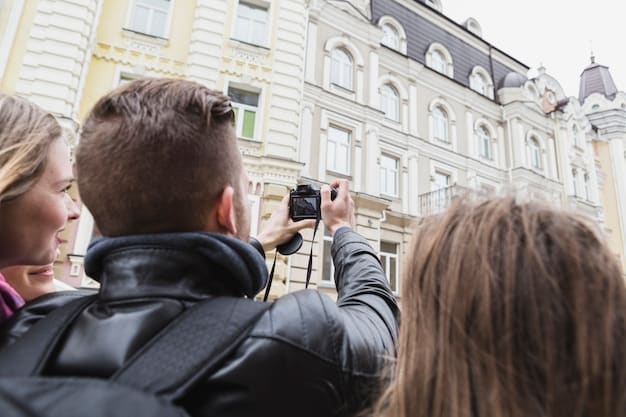
Capturing Movement and Emotion
Streetwear is dynamic, and capturing movement can add an exhilarating sense of life to photographs. This could be a subject striding confidently, skateboarding, or simply gesturing. Using a slightly slower shutter speed can introduce a subtle blur to moving elements, conveying motion while keeping the main subject sharp. This technique highlights the vivacity of urban life and the fluidity of style.
- Burst Mode: Ideal for capturing sequences of action, ensuring you don’t miss the perfect pose or expression.
- Shutter Speed: Experiment with faster speeds to freeze action, or slightly slower speeds for motion blur.
- Candid Shots: Capture genuine emotions and interactions by observing rather than directing subjects.
- Subject Interaction: Engage with your subjects to build rapport and elicit natural reactions.
Emotion is another critical element. A great streetwear photograph not only showcases clothes but also reveals something about the person wearing them. Confidence, swagger, thoughtfulness, or joy—these emotions bring the clothing to life and make the image relatable and impactful. Building a quick rapport with subjects, even if just for a few seconds, can help draw out these authentic expressions.
Ultimately, the best techniques in streetwear photography are those that allow the photographer to adapt to the unpredictable nature of the street. It’s about being responsive, creative, and always ready to find beauty and style in the everyday urban landscape. The ability to anticipate moments and react swiftly often distinguishes a good shot from a truly great one, reflecting the transient yet powerful nature of street style.
Post-Processing for Streetwear Photography
Post-processing is an integral part of modern photography, and streetwear is no exception. It’s where the raw visual data captured by the camera is refined, enhanced, and given its final artistic touch. The goal is to elevate the images without making them look overly processed or artificial, maintaining the authenticity that is crucial to the streetwear aesthetic. This stage allows photographers to define their unique visual signature.
Software like Adobe Lightroom and Photoshop are industry standards, offering comprehensive tools for color correction, exposure adjustment, cropping, and more. Online alternatives and mobile apps also provide powerful editing capabilities, making post-processing accessible to everyone regardless of their equipment or expertise. The key is to understand the balance between subtlety and impact in your edits.
Color Grading and Tonal Adjustments
Color grading is perhaps the most defining aspect of post-processing in streetwear photography. It determines the overall mood and feel of the image. Often, photographers aim for a vibrant, punchy look that reflects the energetic nature of urban fashion. This can involve boosting saturation, adjusting hue shifts, and fine-tuning color balance to make specific elements pop, such as a bold sneaker or a graphic tee.
Tonal adjustments, including exposure, contrast, highlights, and shadows, are equally important. Carefully lifting shadows can reveal hidden details in an outfit, while slightly reducing highlights can prevent blown-out areas in bright cityscapes. A common technique is to slightly crush the blacks to give an image a grittier, more modern feel, contributing to the signature streetwear aesthetic. The aim is to create depth and visual interest.
- Vibrancy and Saturation: Enhance colors to make outfits more striking, but avoid over-saturation for a natural look.
- Contrast: Adjust to add depth and pop, emphasizing textures and details in the clothing and urban environment.
- White Balance: Correct color casts to ensure colors are true to life, especially important for accurate representation of clothing tones.
- Sharpness and Clarity: Enhance details in fabrics, accessories, and urban textures, but use sparingly to avoid artificiality.
Further, selective color adjustments can be incredibly powerful. For instance, if a specific color in an outfit is meant to be the focal point, isolating and enhancing just that color can make it stand out dramatically against the urban backdrop. This level of control allows photographers to guide the viewer’s eye and emphasize key elements of the streetwear ensemble.
Another common approach is to use split toning or color grading tools to apply specific color casts to highlights and shadows. This can create a cohesive color palette across an image, enhancing its artistic appeal. For example, adding subtle blue tones to shadows and warm orange tones to highlights can create a cinematic, desaturated effect that is often seen in contemporary streetwear imagery.
Retouching and Local Adjustments
Retouching in streetwear photography usually focuses on cleaning up distractions rather than extensive alteration of models. This includes removing litter from the background, subtly cleaning up skin imperfections without making it look artificial, or removing minor blemishes from clothing. The goal is maintain authenticity while presenting the subject and their style in the best possible light.
Local adjustments allow for precise control over specific areas of an image. Using brushes or gradient tools, photographers can selectively brighten an outfit, darken a distracting background element, or add sharpness to a particular detail like a sneaker emblem. This precision ensures that enhancements are made exactly where needed, contributing to a polished yet natural final product. The art of retouching lies in its subtlety.
It’s important to approach retouching with a light hand. Over-retouching can strip an image of its authentic, raw street feel. The imperfections of the urban environment and the natural appearance of the subject are often what give streetwear photography its unique charm. Therefore, any adjustments should serve to enhance, not detract from, this intrinsic character.
One technique is dodge and burn, which involves selectively lightening or darkening areas to sculpt light and shadow, adding dimension and drawing attention to key features of the apparel. This can be particularly effective in emphasizing the folds of fabric or the shape of a garment, making the clothing appear more tactile and appealing. These fine-tuning processes are what truly differentiate a snapshot from a carefully crafted photographic statement.
Finding Your Niche and Style
In the expansive world of streetwear photography, finding and cultivating your distinct niche and personal style is crucial for standing out. While the overarching theme revolves around urban fashion, the interpretations can vary wildly, from gritty, documentary-style shots to highly stylized and conceptual compositions. Discovering what genuinely resonates with you, and then refining that vision, becomes the bedrock of your photographic identity.
Begin by exploring different facets of streetwear. Are you drawn to vintage aesthetics, modern minimalism, or perhaps the edgy, avant-garde side of the spectrum? Your passion for a particular subgenre will naturally guide your choices in subjects, locations, and even the technical approach to your photography.
Developing a Unique Perspective
A unique perspective is your most valuable asset. This isn’t just about technical skill; it’s about seeing the world—and streetwear—in a way that only you can. It involves your personal narrative, your individual tastes, and the way you interpret the culture. Think about what emotions you want to evoke, what stories you want to tell, and what aspects of streetwear you find most compelling. This introspection will help shape your artistic voice.
Experimentation is key in this process. Try different angles, play with light in unconventional ways, and challenge conventional compositions. Don’t be afraid to break rules once you understand them. It’s through this process of trial and error that truly innovative and distinctive styles emerge, separating your work from the multitude of similar images on social media and digital platforms.
Building a Portfolio and Brand
Once you’ve started to define your style, building a portfolio that eloquently showcases your best work is the next crucial step. This portfolio serves as your visual resume, demonstrating your capabilities and creative vision to potential clients, collaborators, or simply a wider audience. Ensure the portfolio is cohesive, reflecting a consistent aesthetic that is immediately recognizable as yours.
- Curate Selectively: Only include your strongest work that truly represents your best.
- Tell a Story: Your portfolio should communicate who you are as an artist and your unique approach.
- Online Presence: Establish a professional website or use platforms like Instagram or Behance.
- Network Constantly: Attend fashion events, connect with designers, models, and other photographers.
- Stay Consistent: Regular posting and engagement help maintain visibility and build a loyal following.
Beyond the portfolio, cultivate a personal brand. This involves not only your visual style but also your online presence, your communication style, and how you interact with the community. A strong brand helps you attract like-minded individuals and opportunities, turning your passion into a sustainable endeavor. Authenticity in your brand image is just as important as in your photography.
Networking within the streetwear community is invaluable. Attend fashion events, connect with designers, stylists, and models. Collaborative projects can not only expand your portfolio but also introduce you to new perspectives and techniques. These connections often lead to unexpected opportunities and reinforce your position within the industry.
Finally, continuous learning is essential. The streetwear landscape is constantly evolving, influenced by global trends and emerging subcultures. Stay curious, follow new brands, and observe how other photographers interpret the scene. Adaptability, combined with a strong personal vision, will ensure your work remains relevant and impactful in the ever-changing world of urban style photography.
The Cultural Significance of Streetwear Photography
Streetwear photography transcends mere fashion documentation; it acts as a powerful lens through which cultural shifts, societal values, and individual expressions are captured and disseminated. It’s a dynamic visual archive that reflects the pulse of urban communities, highlighting their creativity, resilience, and unique identities. This genre offers more than just aesthetic appeal; it provides sociological insights into an ever-evolving global phenomenon.
By capturing how individuals appropriate and transform mainstream trends, streetwear photography illustrates the democratizing power of fashion. It shows how style emerges from the ground up, fueled by subcultures, music, art, and street-level innovation, rather than being dictated solely by high fashion runways. This makes the images inherently valuable as historical and cultural artifacts.
Documenting Urban Narratives
Every streetwear photograph tells a story—not just of an outfit, but of the person wearing it and the environment they inhabit. It documents the daily lives, aspirations, and struggles within urban settings, transforming clothing into a form of self-expression and cultural commentary. The settings—gritty alleyways, iconic city landmarks, bustling markets—become integral characters in these visual narratives, adding depth and context to the style.
These images often highlight distinct local nuances, from regional fashion interpretations to specific cultural gatherings that influence style. They serve as a testament to the diversity of urban life, showcasing how style is adapted and reinvented across different neighborhoods and communities. In essence, streetwear photography becomes a form of ethnographic documentation, preserving fleeting cultural moments.
Streetwear as a Global Movement
What began as niche subcultures in various localized urban centers has exploded into a global phenomenon, and streetwear photography has been instrumental in its widespread adoption. Through platforms like Instagram, Tumblr, and dedicated fashion blogs, these images travel instantaneously across continents, influencing trends and inspiring style practitioners worldwide. This rapid dissemination has accelerated the evolution of streetwear, creating a constant dialogue between diverse cultural pools.
- Cross-Cultural Exchange: Images facilitate the blending of global and local fashion influences.
- Trend Dissemination: Photography quickly spreads new styles and aesthetics across borders.
- Community Building: Photography platforms foster connections among enthusiasts globally.
- Brand Identity: Visuals are key in shaping how streetwear brands are perceived and consumed worldwide.
The visual language of streetwear photography has become a universal currency, allowing enthusiasts from Tokyo to New York to communicate and connect over shared aesthetic values. This global reach means that a photographic trend initiated in one city can catalyze similar movements in another, creating a rich tapestry of stylistic exchange that defies geographical boundaries. It’s a powerful illustration of how visual media can drive global cultural shifts.
Moreover, these photographs often blur the lines between high fashion and everyday wear, proving that style is ubiquitous and accessible. They celebrate authenticity and individuality over exclusivity, a core tenet of the streetwear ethos. By presenting fashion in its natural habitat—the street—photographers demonstrate that true style originates where people live, work, and express themselves most freely.
Ultimately, streetwear photography holds significant cultural weight because it encapsulates the dynamism of urban life. It freezes moments of fashion-forward expression, documenting a powerful self-identity that resonates deeply within fragmented modern societies. Its power lies in its ability to not just show what people wear, but to reveal who they are and what their style means in the broader social context.
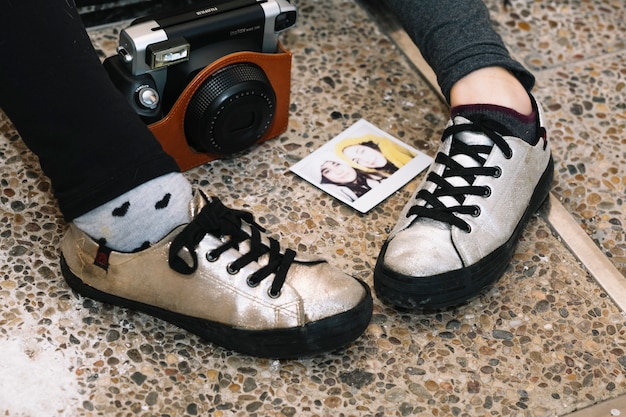
Ethical Considerations in Streetwear Photography
As with all forms of photography that involve capturing moments of people in public spaces, streetwear photography comes with its own set of ethical considerations. While the urban environment often lends itself to candid shots and spontaneous interactions, it’s crucial for photographers to navigate these situations with respect, awareness, and a strong sense of responsibility. The goal is to capture compelling images while upholding the dignity and privacy of those being photographed.
The line between public and private space can be blurry, and what might be legally permissible isn’t always ethically sound. A thoughtful approach ensures that the art form contributes positively to the community it seeks to represent, rather than exploiting individuals or perpetuating stereotypes. This involves constant self-reflection and adherence to a personal code of conduct.
Respecting Privacy and Consent
The primary ethical consideration is obtaining consent. While photographing people in public doesn’t always legally require explicit permission, seeking consent, especially for close-up or identifiable portraits, shows respect. A simple head nod, a verbal “okay,” or a quick chat can go a long way in building trust and making the subject feel comfortable and valued. This interaction can even lead to more natural and striking images.
When subjects are clearly identifiable, consider whether their portrayal aligns with how they would wish to be seen. If photographing children, always seek parental consent. If a person expresses discomfort or asks you not to take their photo, respect their wishes immediately. The street is a shared space, and every individual has a right to their own image and privacy within it.
- Ask Permission: When possible, engage with subjects to ask for their consent, especially for direct portraits.
- Be Discreet: For candid shots, use longer lenses or blend into the environment to avoid being intrusive.
- Respect Refusals: Always honor a subject’s request not to be photographed or to delete an image.
- Avoid Stigmatizing: Do not exploit vulnerable individuals or situations for artistic gain.
- Context is Key: Be mindful of how your photos might be interpreted and ensure they don’t misrepresent the subject or scene.
Beyond the initial shot, consider the broader implications of publishing images. If a photograph carries any potential for misinterpretation or negative impact on the subject, it’s best to err on the side of caution. This diligence underscores a commitment to ethical practice, fostering a reputation for trustworthiness and integrity within the photography community.
It’s also about knowing your audience and the potential impact of your images. Are you capturing genuine street style, or are you creating a caricature? Ensuring your work is respectful and authentic avoids reinforcing stereotypes that can damage the very community you aim to represent. The power of the lens comes with the responsibility to wield it thoughtfully and ethically, highlighting the multifaceted beauty of urban life without exploitation.
Responsible Use of Images
Once photos are taken, ethical considerations extend to their publication and use. Be transparent about where the images will be shared and for what purpose, especially if you secured consent beforehand. If photos are used for commercial purposes, secure model releases. This not only protects you legally but also ensures fairness to the subjects whose likeness you are profiting from.
Avoid sensationalizing poverty, portraying individuals in a dehumanizing way, or misrepresenting the context of a scene. Streetwear photography should celebrate the subject, not reduce them to an object. Reflect on the power dynamics at play—you, as the photographer, hold significant power in how you frame and present your subjects. Use this power responsibly and with empathy, ensuring your work contributes positively to the visual discourse of urban fashion.
Crediting subjects, if they are known and wish to be credited, is also a good practice, especially if they are influencers or designers within the streetwear community. This fosters a collaborative spirit and gives due recognition. Ultimately, ethical streetwear photography is about striking a balance between artistic pursuits and a profound respect for human dignity and autonomy, making the streets not just a backdrop, but a dynamic, lived space recognized for its true vibrancy.
| Key Aspect | Brief Description |
|---|---|
| 📸 Authenticity | Capturing genuine style and moments in urban settings is key to the genre. |
| 💡 Lighting mastery | Utilizing natural and urban light forms the mood and drama of the shots. |
| 🏙️ Urban Narrative | Each photo tells a story, blending fashion with the cityscape’s essence. |
| 🤝 Ethical Practice | Respecting privacy and ensuring responsible image use is paramount. |
Frequently Asked Questions About Streetwear Photography
▼
The main goal of streetwear photography is to authentically capture urban style and the essence of city culture. It focuses on documenting how individuals express themselves through fashion in their everyday environments, highlighting spontaneity, personality, and the dynamic connection between clothing and urban life. It moves beyond traditional fashion shoots to reflect a more grounded reality.
▼
A good streetwear photo blends strong composition, effective use of urban light, and a genuine portrayal of the subject’s style and emotion. It often captures candid moments, showcases unique outfits, and incorporates the urban environment as an integral part of the narrative. Authenticity and a strong visual narrative are key elements for impactful images in this genre.
▼
For beginners, a versatile mirrorless or DSLR camera with a fast prime lens (like a 35mm or 50mm) is a great starting point. While advanced gear helps, mastering fundamental photography principles like composition, lighting, and subject interaction is more crucial. A comfortable camera strap and extra batteries are also highly recommended for long shooting sessions on the streets.
▼
Post-processing is highly important in streetwear photography, as it allows photographers to refine images, adjust colors, enhance contrast, and correct imperfections. It’s crucial for establishing a consistent visual style and elevating the aesthetic quality of the photos. However, the aim is to enhance the image subtly, preserving its authentic, raw street feel rather than over-editing it.
▼
Ethical considerations for streetwear photographers include respecting privacy, seeking consent when possible, and being mindful of how subjects are portrayed. It’s important to avoid exploitation, misrepresentation, or any actions that could compromise a subject’s dignity. Responsible use of images, ensuring they highlight the vibrant diversity of street culture without judgment, is also paramount for ethical practice.
Conclusion
In essence, streetwear photography: capturing the essence of urban style is an evolving art form that continues to reflect and shape global fashion trends. It is a powerful blend of technical skill, artistic vision, and cultural understanding, demanding photographers to be both keen observers and respectful participants in the urban narrative. By embracing authenticity and ethical practices, photographers not only create captivating images but also contribute meaningfully to the ongoing visual chronicle of street culture, ensuring its vibrant legacy endures.
